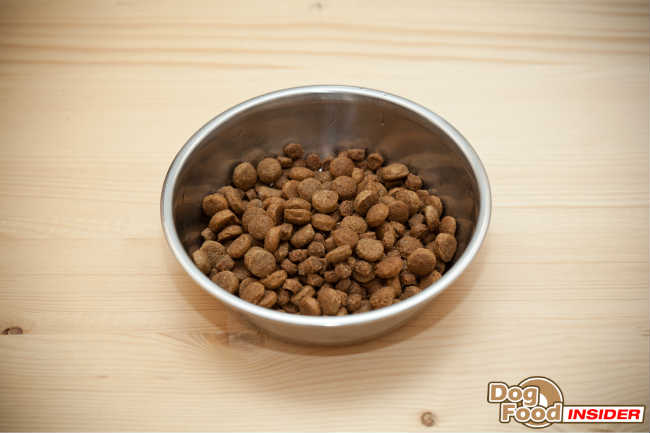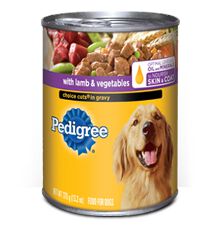
This post may contain affiliate links. We are compensated for referring customers to our affiliate partners.
[su_note note_color=”#ffffff”]
Dog Food Insiders Rating
![]()
3 1/2 PAWS
You can find detailed information about Mars Inc., manufacturer of Pedigree dog food, in our full Pedigree dog food review. There you will also find information about how the food is made, recalls, the manufacturing process and their quality control measures.
The Pedigree brand includes dry and canned foods as well as treats and snacks. They also produce foods that are targeted for oral care, hip and joint health, weight control, and other health concerns. Like many other brands, they divide their foods by age – adult, puppy, and senior foods; and by the size of the dog – small, medium, large breed.
In the marketplace, Pedigree is an old, established brand and it is sold in grocery stores. It can be found nearly anywhere pet foods are sold. It is priced to fit lower budgets.
Ingredients in Pedigree Choice Cuts in Gravy Canned Dog Food
Sufficient Water For Processing, Chicken, Meat By-products, Wheat Flour, Lamb, Liver, Wheat Gluten, Peas, Salt, Carrots, Sodium Tripolyphosphate, Natural Flavors, Guar Gum,Vegetable Oil (source of Linoleic Acid), Minerals (Potassium Chloride, Zinc Sulfate, Copper Sulfate, Potassium Iodide), Sodium Alginate, Caramel Coloring, Xanthan Gum, Bay Leaves,Onion Powder, Vitamins (Vitamin E, A & D3 Supplements, D-calcium Pantothenate, Thiamine Mononitrate {Vitamin B1}, Biotin), Garlic Powder, Sodium Nitrite (for color retention)
Top 5 Ingredients Breakdown
The first five ingredients in this food are: Sufficient Water For Processing, Chicken, Meat By-products, Wheat Flour, Lamb.
Pedigree Choice Cuts in Gravy (or Sauce) is a product line that includes several product varieties.
Pedigree Choice Cuts in Gravy Blends
- With Lamb & Vegetables
- Country Stew
- With Beef
- With Beef & Barley
- With Beef & Liver
- With Beef & Rice
- With Chicken
- With Chicken & Rice
All of these varieties feature meaty chunks in a savory gravy or sauce. With the exception of the main meat products, they are very similar, with similar ingredients and guaranteed analyses (protein, fat, fiber, and so on).
Since they are canned foods “in gravy” or “in sauce” that means you can count on the food being made up of around 82 percent water. The rest of the product – around 18 percent of the contents – is the actual food that your dog eats. The moisture content and the “dry matter basis” are considered below when figuring the protein, fat, and fiber percentages of the food.
The first ingredient listed for the food is the water content: “Sufficient Water For Processing.” The food also contains a couple of whole meat products which also include water weight before cooking, which adds more water.
The second ingredient in the food is chicken. This is whole chicken and it’s a good ingredient but it does include fat and water weight before cooking, as well as bones and skin. It’s the entire chicken. Chicken is about 80 percent protein and it’s a good source of Vitamin B6 and Phosphorus, and a very good source of Niacin and Selenium.
The third ingredient is meat by-products. AAFCO defines meat by-products as:“The non rendered, clean parts, other than meat, derived from slaughtered mammals. It includes, but is not limited to, lungs, spleen, kidneys, brain, livers, blood, bone, partially defatted low-temperature fatty tissue and stomachs and intestines freed of their contents. It does not include hair, horns, teeth and hooves.” So, there are some desirable organ meats included in this ingredient but it’s a mixture of parts. You probably wouldn’t want your dog to eat some of these things. The most problematic part of “meat by-products” is that you have no idea which animals they come from. “Meat” is a generic term so it can refer to any kind of slaughtered animal.
The fourth ingredient here is whole wheat. This is usually considered a filler ingredient and it’s something like flour. It’s also used as a binding and thickening agent, which is necessary in canned foods to make the gravy. However, it does have about 15 percent protein, 5 percent fat, and 80 percent carbohydrates. It’s considered to be a good source of dietary fiber. If your dog has any problems with wheat or grains, in general, you will need to avoid this food.
The fifth ingredient in the food is lamb. This refers to whole lamb so it still contains the fat and moisture in the meat. Lamb is an excellent source of protein in dog food. It’s also a good source of Vitamin B6, Pantothenic Acid, Phosphorus and Manganese. It’s also a very good source of Vitamin A, Riboflavin, Niacin, Vitamin B12, Iron, Zinc, Copper and Selenium. It’s even a good source of omega-6 fatty acids.
Three of the first five ingredients in this canned food are meat proteins: chicken, meat by-products, and lamb. Meat by-products are not the most desirable meat protein for your dog since their source is unknown, but this is a lot of meat protein for your dog. It’s hard to guess how much wheat flour is in the food but some of it is probably necessary as a binder in the wet food and to help make the gravy.
Additional Ingredients of Interest
The food contains liver as the sixth ingredient. We don’t know if this is beef liver, pork liver, chicken liver, etc., but liver is a good source of protein, vitamin A, and other vitamins and minerals. Plus, most dogs love it. This is a good addition to the food.
The food also contains carrotsin the middle of the ingredient list. Carrots are an excellent source of Thiamin, Niacin, Vitamin B6, Folate and Manganese, and a very good source of Dietary Fiber, Vitamin A, Vitamin C, Vitamin K and Potassium.
The food also contains Vegetable Oil (source of Linoleic Acid). Vegetable oil is often added to dog foods. The only possible problem with it is that you don’t usually know the source of the vegetable oil. In some cases it can be recycled oil which would be undesirable.
There are some ingredients in the food that may cause dog owners to pause. The food contains onion powder, garlic powder, and bay leaves. I have no idea why a dog food manufacturer would add bay leaves to their dog food. I’ve never seen this in a dog food before. Checking online, I can only find one brief reference to bay leaves and dog food in a site on Chinese herbal medicine. Perhaps they are added for taste. Even so, most cooks remove bay leaves before serving food. Bay leaves should not harm your dog but I doubt they will have any positive effects either. (One of my dogs once ate a small bay tree in my yard and suffered no harm. I think she simply liked the scent.)
As for onion powder and garlic powder, you’ve probably been warned that you should never give onion to dogs and there are some concerns about giving too much garlic. This is true. On the other hand, there are some dog foods that use these additives for flavoring. It’s unlikely that these powders, in small amounts, will harm your dog when added to a dog food. If you are concerned about giving your dog food with these ingredients, skip this food.
Ingredients Of Concern
We note that the food contains wheat gluten as the seventh ingredient. This is still prominent in the ingredient list and so probably makes up a good deal of the food. Wheat gluten is the main protein found in wheat. It’s used as a source of protein and as a binding agent in pet foods. You might be familiar with wheat gluten because it was implicated as one of the tainted sources of melamine in the 2007 pet food recalls. Many pet food manufacturers have put in place in-house testing now to identify any contaminant like melamine so this kind of poisoning from an outside source won’t happen again.
The concern with wheat gluten isn’t that it could be contaminated. It’s simply that, together with the wheat flour in the food, it makes up a great deal of the protein content found in the food. However, in this case there seems to be a lot of meat protein in the food along with the plant protein.
The food also contains “natural flavor.” This is a deceptive term that often indicates the presence of MSG or monosodium glutamate used for flavoring. This isn’t something that you generally want to add to your dog’s food unless you have a particular object in mind, such as discouraging your dog from eating his own poop. MSG is sometimes recommended as a supplement to make your dog’s waste taste bad to him so he won’t try to eat it. Otherwise, when a food has “natural flavor,” it usually has a lot of salt which isn’t good for your dog.
The food also contains caramel coloring. Coloring is added to appeal to the buyer and there is no real need to add coloring to your dog’s food. You can find more information about caramel coloring here. It’s a more complex subject that most people realize.
The food also contains peas. Peas are a problematic ingredient in dog food for some dogs. Although they boost the protein percentage in food, containing about 24 percent protein, they are also a source of dietary fiber. Peas are not always easily digested by dogs and can result in increased waste and some gastrointestinal issues. They can also interfere with the absorption of vitamins and minerals in the food read more here.
Guaranteed Analysis
- Crude Protein Min. ………. 8%
- Crude Fat Min. ………. 3%
- Crude Fiber Max. ………. 1%
- Moisture Max. ………. 82%
- Linoleic Acid Min. ………. 0.7%
- Vitamin E Min. ………. 25 Iu/kg
Calories Content
206 calories per 8 oz cup
Nutritional Adequacy Statement
Pedigree Choice Cuts In Gravy Food For Dogs With Lamb & Vegetables is formulated to meet the nutritional levels established by the AAFCO dog food nutrient profiles for maintenance.
Dry Matter Basis
Dry matter basis allows us to compare dry kibbles and wet canned food by removing the moisture content from the food. When you look at the labels it may seem that kibble has higher percentages but that’s because kibble has less moisture. Once you account for the moisture in the foods, canned food usually has a higher protein percentage than kibble. On a dry matter basis, this food contains approximately 44.4 percent protein and 16.6 percent fat. Fiber makes up about 5.6 percent of the food. This is one reason why dogs like canned food so much – the higher protein and fat content tastes very good to them. This is a fairly high protein percentage, even for a canned food; while the fat percentage is modest and the fiber percentage is typical for canned food.
Summary
This food contains a lot of meat protein, as well as some plant protein from wheat and wheat gluten. The main concerns with the food are the caramel coloring and the “natural flavors” which are not as natural as some owners could wish. But this seems like it would be a good, tasty food for many dogs.

Help Support This Site And Get Pet Food Delivered To Your Doorstep!
Buy your dog food with the convenience of Chewy.com and help support this website at the same time! If you click on any of the Chewy.com links or banners on this website, and then make a purchase (no matter what you buy), we receive a small commission on your entire purchase! How cool is that?! We would really appreciate your support and every penny earned through our Chewy commission helps to improve this site and add even more dog food reviews. 🙂
(We Are Incredibly Thankful For Your Support!)
From Pedigree Choice Cuts in Gravy To The Full Pedigree Dog Food Review


